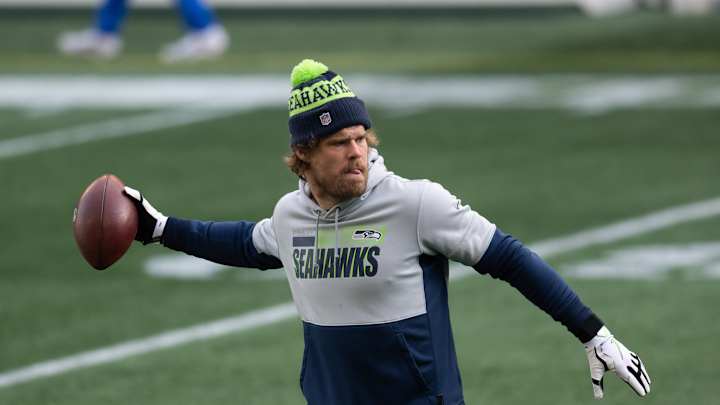Greg Olsen's Contract Proved Disastrous for Seahawks in 2020

One year ago, the Seahawks were coming off a brutal road playoff loss to the Packers in the divisional round and had plenty of needs to address entering the offseason, particularly at the edge rusher spot. That’s why when they signed tight end Greg Olsen to a one-year, $7 million contract with limited salary cap space to begin with, fans of the team were left confused.
It’s not that the tight end position wasn’t a place of need for them, to be fair. Jacob Hollister was a revelation in 2019, but behind him was the lone Will Dissly, who suffered a torn achilles against the Browns earlier that year. They would bring Luke Willson back later on in the offseason, but Seattle ultimately had just one healthy tight end under contract once the season ended.
There’s no surprise why the Seahawks liked Olsen. The tight end’s 14-year career, which came to an official end per Olsen’s announcement during the NFC championship broadcast on Fox this past Sunday, may very well put him in the Pro Football Hall of Fame in a few years time. Having a savvy, veteran pass-catcher for Russell Wilson to lean on in crunch time was certainly appealing.
But consider the circumstance; Olsen was 34 years old, coming off three mediocre, injury-plagued seasons, and basically had one foot already into retirement with sights set on the broadcast booth with the NFL on Fox. It was a head-scratcher at the time, but throw in the near $7 million salary cap hit he carried in 2020 and the deal appeared disastrous right out of the gate.
Olsen’s time with the Seahawks actually started out on a positive note. He hauled in all four of his targets for 24 yards and a touchdown in Seattle’s season opening victory over the Falcons. That good feeling wouldn’t last long, however, as Olsen quickly found his way right out of the team’s offensive game plan following a disastrous dropped pass that bounced right into the hands of Patriots safety Devin McCourty for a pick-six on their opening drive the next week. It would be his only target that night, despite playing in 71 percent of the offensive snaps.
The next two weeks were considerably better for Olsen, who caught a total of 10 passes for 96 yards against the Cowboys and Dolphins. In the Dallas game, Olsen had several clutch catches that helped the Seahawks come out on top and showed exactly what the organization had hoped for when they signed him.
After the team’s trip to Miami, however, Olsen saw his involvement with the offense diminish greatly. Over his next six games, the University of Miami (FL.) alum was targeted by Wilson a mere 17 times before suffering a plantar fascia injury against the Cardinals in November that seemingly ended his season - and career - abruptly.
Originally signing with the Seahawks for the sole purpose of winning a championship before hanging up his cleats, Olsen fought his way back to shockingly play in the team’s 20–9 division-winning game against the Rams just five weeks following the injury, even catching a pass for 15 yards.
He clearly wasn’t anywhere close to being 100 percent healthy though, not even playing in a quarter of the team’s offensive snaps in that game. He’d miss the season finale against the 49ers the following week, then see his usage dip even more versus Los Angeles in the wild-card round where he wasn’t targeted.
While Olsen’s toughness - particularly toward the end of the season - is due all the respect in the world, the Seahawks’ incredibly risky move to sign him to the contract they did blew up in their face. In hindsight, it’s hard not to wonder what could have been had Seattle allocated those funds elsewhere.

Reporter and editor covering the Seattle Seahawks for All Seahawks. Host of Locked On Mariners.
Follow danegnzlz